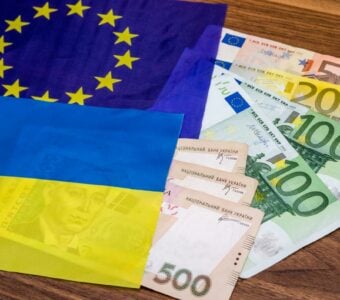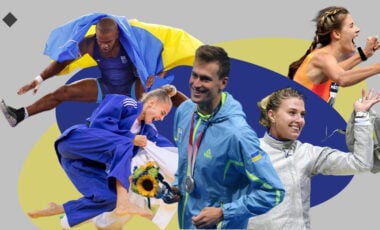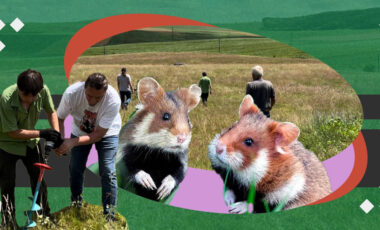Ukrainian Christmas traditions: what's Didukh and how to make it
And why you can have both a Christmas tree and Didukh at home for holidays

A lavishly decorated Christmas tree with a shining octagonal star on top is an indispensable attribute of Christmas, the main religious holiday of the year. However, this wasn't always the case in Ukraine. Folk traditions of celebrating Christmas have roots far back in the pre-Christian era since our ancestors began to celebrate Nativity in the light of God. This holiday occupied the most honorable place among others since people understood the cyclical motion of the Sun and its significance for all living things.
Peter the First brought the European habit of installing a Christmas tree to our lands. Still, even in the early twentieth century, Ukrainian villagers used to place not a Christmas tree but Didukh, a sheaf-amulet bound with ears, which symbolized an excellent harvest, family well-being, peace and harmony in the family, the connection between the family generations and eternal rebirth of light.
Family and world tree
The word "Didukh" means "the eldest." The venerable Didukh has many names: grandfather, carol, caroler, sheaf, and king.
From the Old Slavic, the word "didukh" translates as "ancestral spirit" and symbolizes Grandfather, the family's ancestor. Didukh is also a sacrifice of the best bundle to the forces of nature.
Didukh can be considered a World Tree, which unites and supports all worlds. Thanks to "legs," it stands firmly, representing the roots, the world of the dead. The upper part, which symbolizes the middle world, the world of people, has seven spikelets in each bundle. Seven is one of the symbolic numbers: seven weekdays, seven generations, and seven rainbow colors. Spikelets' seeds are the upper world with deities, birds, and solar symbols.
Didukhs were made from unthreshed ears of grain, used for baking bread, like oats, rye, and wheat, most often from the last sheaf in the field. They believed that the reaper who knitted the last bunch of rye would soon give birth to a child because the sheaf-binding symbolically resembled tying the umbilical cord.
Festive "trees" were decorated with dried flowers, viburnum, and colorful ribbons and placed in the most honorable place in the house, at the sacred corner. As believed, together with Didukh, the spirits of grandfathers-ancestors, patrons of each house, were in the house during the holidays.
"Didukh in the house, trouble out of the house."
As soon as the first Christmas star rose on January 6, a festive sheaf, Didukh, was brought to the house. In the meantime, they summoned: "Didukh to the house, trouble out of the house." In honor of ancestors' spirits, they necessarily put a new pot with a koliva (typical dish), namely, kutia and uzvar, near Didukh.
In Polissia, preparing for the evening meal, the host grandly brought Didukh to the house; ceremonial dialogues and sayings accompanied this scene:
— Help God!
— God bless you!
— What are you carrying?
— I'm carrying gold!
In the Hutsul region, when a decorated oat sheaf was being brought into the house, people invited various evil forces (storms, hail, wolves, etc.) to dinner because they believed it'd help them escape the forces in the future.
In Ukraine's East, entering the house, the father said: "Holidays are coming!" "Holidays have come!" the son replied to his father. "We respect and ask Didukh and you to visit the Lord!" the mother answered.
The Christmas tree stayed in the house until the New Year, in some places, until the Epiphany. Then the grain was threshed and added to the seed. The straw was burned so the souls of the dead, who visited the family on holidays, could return to heaven.
It'd be wrong to talk about Didukh as a solely past phenomenon. Lviv has a long-standing tradition of installing the great Didukh in the city center for the Christmas holidays. Straw talismans are also installed on squares in Kyiv, Vinnytsia, Ivano-Frankivsk, Ternopil, and other cities.
Many folk artists make didukhs for museum exhibitions and sales. For people interested in ethnography, finding a ready-made didukh or ordering it online isn't a problem now. But true connoisseurs of Ukrainian people's cultural heritage advise learning how to knit the king of sheaves, and they're right. Of course, the handmade Didukh will bring you and your family a lot of unique emotions and pleasure and allow you to feel the breath of history. So recreate it today.
How to make a didukh
There were various manufacturing technologies in Ukraine for a long time: didukhs were braided, made as a bundle, or as a tree.
The major obstacle modern city residents may face while preparing for weaving is the difficulty purchasing material for didukhs. But you can find spikelets and straw at the markets or ask your village relatives about them.
- You'll need at least twenty-one spikelets.
- Before work, soak them briefly in hot water to make them soft and supple.
- Then disassemble the ears by size. You should have seven pieces in one bundle (symbol of family, weekdays, and seven generations).
- Each seven should be tied evenly, carefully, and firmly with rope.
- Then gather the bundles by levels to get a beautiful "head."
- Divide the bundle into three "legs" (if there are many spikelets, then five or seven). You can attach a few strong straws to the base to make Didukh more stable.
The most common traditional option is Didukh as a year. The composition includes four tiers, symbolizing the four seasons. Each level has three branches, i.e., months. Each branch makes four bundles, including seven spikelets (they suggest weeks and days). When assembling a Didukh, you can use different grain types for each tier. Each grain represents a particular time of year.
Ancestors believed that the richer Didukh looked, the more productive the year would be. So decorate it splendidly with dried and paper flowers, berries, ribbons, and nuts. Some masters add herbs to the decorations, mostly healing ones. They're woven for a reason: St. John's wort brings health, and poppy brings money.
Ukrainian Christmas spider—amulet, harmonizer, family doctor
But if you can't find materials for making a didukh this year, don't worry. Nowadays, a small bouquet of spikelets, various dried herbs, and flowers, like immortelles, often replaces the ritual sheaf. In addition, Ukrainian ideas about world creation are also reflected in an authentic Christmas decoration, a "spider, weaving" the web of the universe and life. And it's much easier to make.
Ancestors considered "spiders" a talisman and a symbol of the universe. With the advent of Christianity, the "spider" received support from the religion. According to legend, the living spider netted the entrance to the cave where the Virgin Mary and Child hid from the soldiers of Herod and thus saved the Holy Family from death.
Every year before Christmas, Ukrainian women and girls made home decorations, like spiders, hedgehogs, and pigeons, carved vytynanky (paper decorations), and made angels, bells, stars, and other toys of straw and grass. A good mood, smiles, and ritual songs accompanied their work.
For the "spider," they cut straws in different sizes, strung them on threads, and formed a variety of triangles, squares, and cubes from them. The straw "spider" was hung on horsehair to the ceiling, spinning and moving from the slightest puff of air. "Spider" protected the family from negative energy, absorbed it into its "web," helped a woman get pregnant, and fulfilled the most cherished desires. The "spider" was also a family doctor. If someone felt terrible, the person needed to stand under it, and the patient's condition immediately improved.
They also made "spiders" from thin twigs or wire. Paper flowers, candles, and decorations were attached to the joints. The best material for weaving spiders in modern times is ordinary cocktail straws or even an old dismantled broom. The delicate and dynamic design of the Christmas "spider" will look attractive and harmonious in today's interiors.
Employees of the Gonchar Museum in Kyiv note that one can still find miniature "spiders" in villages under icons. However, few people, even the older generation, know what these straw ornaments were intended for; they create and use them because "that's what their parents did."
It's hard to believe, but Ukrainian "spiders" could be found on Soviet Christmas trees. They were "woven" from long shiny glass tubes and were much smaller and shallower than the authentic ones. But it's impossible to confuse them in a form with anything else. Who knows, maybe one of the designers at the Soviet factory of Christmas decorations was a conscious Ukrainian and thus tried to support the spirit of ancestors and preserve the memory of his people.
Didukh is one of the traditional symbols of Ukrainian primary origins. It brings comfort, an incredible mood, and festivity to the family. Religious people may be interested in what the church thinks of this pagan symbol. Is it possible to combine a Christmas tree with Didukh? After all, now we wish to rely on something eternal, on roots and principles, as a sign of the stability we all lack so much this year. Archpriest Oleksandr Dediukhin, the rector of St. Nicholas Church in Poltava, answers: yes, you can combine them if you perceive the Didukh not as a spirit but as a memory of ancestors.
Didukh is an ancient symbol of the Christmas holidays and the connection between generations, which must be inseparable. So create actual Ukrainian ornaments and didukhs from spikelets and straw, and sow grain in spring, albeit symbolically. Let's revive this great old Ukrainian tradition.
As reported, the main Didukh was made with a record height in Lviv.
































































